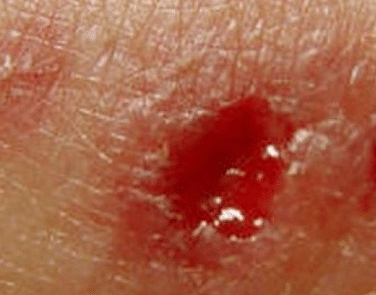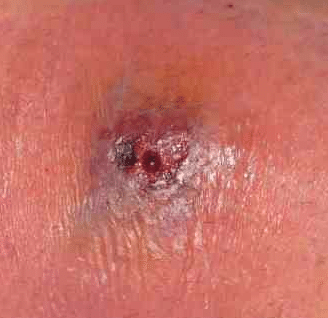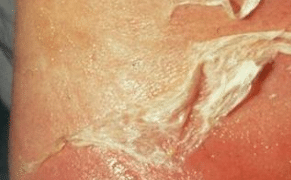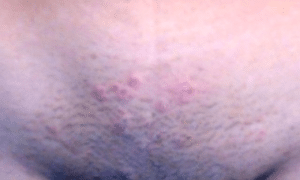Does a wolf spider bite? A critical look at the wolf spider bite, pictures, identification, symptoms, images, how to get rid and treatment.

wolf spider picture
Wolf Spider Bite Pictures
Considered by most people as a highly dangerous as well as very painful experience. Because of its looks and also habits, the wolf spider has for years earned a reputation of being a very much vicious predator and is even normally mistaken for a tarantula.
Though they should be taken very serious, wolf spider bites are not as fearful as the reputation. It is thus vital to understand some of the basic facts about the wolf spider and also knowing how to identify a wolf spider bite and what treatment is required.
Usually, wolf spiders are never seen inside the homes, except during the autumn and also winter when they are seeking for warmer places so as to shelter. They are very active hunters and do not even spin webs so as to catch prey.
They also stalk their prey or also pounce on them using their very fast reflexes as well as agility. This, adds to the fear-inducing false information that usually circulates about them, with most of the people believing that they deliberately try to bite the humans.
A wolf spider bite normally happens due to the ignorance on the part of the people, and fear that is on the part of the spider. Contrary to the popular urban legends, the spider does not go out to bite people. But, when a wolf spider is very afraid, or feels that it is being threatened, then it will bite without any hesitation.
Wolf spiders are the hairy arachnids that normally grow up to about 40 mm in their body length. Their bodies are usually patterned in black, gray or having brown hues. Quick moving as well as relatively large in size, wolf spiders normally inspire fear when they are found within the human dwellings. Wolf spiders are also confused for the tarantulas, nursery web as well as fishing spiders, and also the brown recluse spiders.
It might also be much difficult to differentiate between the wolf spiders and the most of the species that normally resemble them. Most of the spiders have in common two-segmented bodies, eight legs as well as fang-like mouthparts called chelicerae. But, they do have shorter legs than the web-building spiders and looks more robust than all other species.
What Does a Wolf Spider Bite Look Like?

wolf spider bite picture
After being bitten, the fang marks and also tearing of the skin can be much present, especially if a large spider is the cause of it. But, there is some redness and also swelling that is found in the area.
The number one indication of being bitten by the wolf spider is normally the pain that usually comes with it. The pain can last for up to 15 days together with the swelling in the surrounding skin parts, and also the swelling of the lymph glands. In some other cases, the skin that is around the spot of the bite can darken in color.
A bite from a wolf spider is very venomous but is not usually considered to be that fatal. They are not much like spider bites from the most dangerous black widow and brown recluse spider in terms of the bigger damage and harm that is presented to people.
In some of the severe cases, the bite might be infected and this can cause complications. To prevent this from happening, proper care as well as treatment of the wolf spider bites should be implemented
Wolf Spider Bite Identification
To identify a wolf spider bite, it is crucial to understand what a wolf spider appears like. The wolf spider is normally mistaken for the tarantula due to its similar in appearance. They are also mistaken for the nursery web spiders, but wolf spiders do not usually spin webs and their bodies are very robust than the nursery web spiders, which are normally thin with the pointed rear ends.
- A wolf spider’s identifying characteristic is the number as well as the arrangement of the eyes. A wolf spider has about 8 eyes that are arranged in 3 rows. There are also 4 small ones on the bottom row, 2 very large very much prominent ones on the middle row as well as 2 medium ones that are on top of the head.
The 2 biggest eyes normally glow very much in the dark. Also crucial for identification purposes of the wolf spider is the fact that a female wolf spider can carry its egg sac or even the baby wolf spiders on its back. The most prominent feature of all and also the characteristic to apply for wolf spider identification is the eyes.
- A wolf spider bite is surely painful and can also be a traumatic experience for the person affected. But, a wolf spider bite appears more scarier than it really is. If it is seen, try and avoid disturbing the spider so as to avoid being bitten.
- Although wolf spider bites are normally not as very dangerous as the bites of the hobo spider, the black widow or even the fiddle back spider. Understanding about the wolf spider bite and also about how to identify and also to treat it is the best thing that you can do so as to be prepared in the event of any bite from the wolf spider.
- It might assist to observe the actions of the wolf spider. Named due to their swift motion, particularly while they are attacking prey, the wolf spider may sometimes be observed scurrying across the open surfaces.
The brown recluse, tends to hide in the dark, most unvisited places and is rarely observed in the open places. Recluses also have the six eyes that are arranged in pairs that is combined with a violin thus marking on their particular cephalothoraxes. Wolf spiders do not have the combined characters.
- All spiders however, have in common a two-segmented body, spinnerets and the absence of the chewing mouthparts or even wings. The eight noncom pound eyes of the wolf spider are also arranged with one lower row of the four small eyes, two larger eyes at the middle part and two more small eyes that are on top of the head.
- Chelicerae are used to hold prey, they also inject venom and eat. Two sharp, horizontal fangs are also present at the extreme bottom of the jaws. Also present near the jaw are the palps that are used to serve as sensory structures and also as sperm storage in the male species of the wolf spider.
- The circulatory system of the wolf spider is very much open, implying that the blood isn’t as confined and delivered through the inside parts of the closed system, and have hemolymph, which is a respiratory protein that appears similar in function to the hemoglobin. Hemolymph is thus pumped through their heart and then bathes the internal organs as well as the tissues.
- Wolf spiders do not also spin webs and reside instead within burrows. The burrows can be open or even sealed with the silken doors. In the rainy seasons, wolf spiders normally plug their burrows with the pebbles and also build turrets so as to deflect the floodwater. Twigs can also be placed at the top of the burrow.
- Wolf spider bites are painful, but not very dangerous.The wolf spider bite is usually identifiable by their two tiny red dots where the bite happened. There are many wolf spider bite pictures online that falsely make use of brown recluse spider bite pictures, so it’s very crucial to understand their difference.
In many cases, people have localized reddening and also swelling, similar to the wasp sting, but a bit more painful the pain from wasp sting. Proper spider identification allows for a good knowledge of venom potency.
Chances are it will itch also, but the itching can only lead to further irritation. You may help yourself by rubbing toothpaste or even baking soda on the bite so as to reduce the swelling, use of a cold ice pack, and also taking some of the Tylenol for pain relief. If the swelling starts to spread beyond the bite, then you should seek medical attention urgently.
Wolf Spider Bite Symptoms

wolf spider bite symptoms
A wolf spider bite can be:
- Very much painful
- May lead to swelling and itching
- Reddening of the skin
Though the pain as well as the swelling only lasts for only a few days (14 at most), a wound might become:
- Reddenned
- Swollen at the spot
- Very uncomfortable
- Skin around the bite can turn the color to black and lymph glands can also swell
In some of the rare cases, some can experience an allergic reaction. They can feel:
- Itchiness of the skin
- Nausea at times
- Dizziness most of the time
- Rapid pulse most of the times
If this is the case, such people may need emergency medical care.
How to Get Rid of Wolf Spider Bite
Wolf spiders are very robust, brown spiders range in body size from about 0.05 to 1.19 inches (1 to 35 mm). The spiders are ground-dwelling hunters that usually hide in the dark corners and also the shadows.
Their bites can be painful but are non-fatal and usually harmless compared to the more serious spider bites. But, wolf spiders might still be major pests if the infestation suddenly happens in the home. If you require to do away with wolf spiders in the house or even the workplace;
Change the Outdoor Environment
- Rid the yard of clutter as well as the debris. Clear away all the piles of grass clippings, firewood, or compost.
-
- Dark places normally attract the wolf spiders, which usually hide in the areas during the day. By exposing as much of the yard as possible to the sunlight, then you make the area relatively unappealing to the spiders.
- Do away with the debris and clutter from the yard as much as possible. Even the objects such as empty planters and grills might provide a dark hiding place that can attract wolf spiders.
- Get rid of the vegetation from the perimeter of the house. Move all the shrubs and other heavy, ground-covering plants far away from the building.
- Wolf spiders love to hibernate in very dark places, and areas with low vegetation is among the wolf spider’s best hiding areas.
- If much possible, then get rid of all the heavy ground-covering plants from the yard. If this is not very possible, then you should at least move the plants away from the perimeter and to the outer parts of the perimeter of the yard so as to draw the spiders away from the home.
- Seal the cracks as well as the holes in the outer wall. Make sure that all the cracks as well as the gaps that are leading from the outside parts of the yard are patched up, thus preventing wolf spiders from sneaking in.
- Make use of chalk to fill in gaps and cracks in the side of the foundation or even along the exterior side of the wall.
- Add weather stripping to the doors as well as the windows so as to minimize the risk of allowing a wolf spider to sneak beneath.
- Patch up the broken window screens or even replace the screens much completely.
- Install insect screens. Tightly fix the fine-mesh screen over all vents that lead to the outsideb parts of the yard.
- Pay special attention to the foundation of the vents. While wolf spiders might get into the home through the attic vents, they are ground-dwelling hunters and thus likely enter in through the vents and also crawl spaces along the foundation of the building.
- Remove your outdoor lighting. Lights on the outside of the house attract flies, and other insects at night, thus providing an appealing food source for the wolf spiders.
- Keep the lights turned off so as to limit the number of insects that are drawn to the home.
- Draw the blinds or even the shades closed so as to keep the indoor lighting from flooding out.
- Switch to the sodium vapor lights instead of the standard outdoor lights. These particular lights have a very soft yellow hue that is less likely to attract bugs.
Change the Indoor Environment

wolf spider bite identification and treatment
- Vacuum the yard regularly. Use a broom or even a vacuum cleaner so as to regularly clean the inside.
-
- Sweeping and also vacuuming of the floor gets rid of crumbs that can attract insects. Since insects are a food source for the wolf spiders, having fewer number of insects can imply less food for the wolf spiders, which can deter the spiders from lingering in the compound area.
- Pay close attention to any area that you see the spider webs. Getting rid of the webs usually discourages the spiders from resettling in the same given area.
- Remove cardboard boxes. Ditch boxes that are made from cardboard in favor of airtight containers that are made from plastic.
- It is very crucial to remove the basements, crawl spaces, and other dark areas of the cardboard boxes. Wolf spiders are normally drawn to the dark areas, making them to be more likely to find their way to the cardboard box if it is placed in the dark.
- Airtight plastic containers are very difficult for the spiders to sneak into, but a cardboard box is far much easier for a wolf spider to squeeze itself inside.
- Fill in the gaps. Use of caulk around the tiny cracks as well as the cables that lead to the outside.
- Even if you filled in the gaps outside, it is still very wise to do the same inside, also. There are also some of the gaps that may not have been much visible from the outside parts that you can’t be able to spot easily inside.
Wolf Spider Bite Treatment
Precautions are supposed to be taken with any spider bite, more especially when you are not very sure what type of the spider has bitten you. You should keenly observe the bite area much more attentively and note any gross or given rapid changes.
Here’s what to do:
- The swelling may be treated at home using the application of a cool wet cloth over the bite. The coldness might help to prevent the venom from spreading.
- Washing the wound using an antibacterial soap as well as warm water and also keeping that area clean might assist to prevent infection.
- Elevating the wound and also keeping of the area still may also reduce swelling.
- Do not try to use a tourniquet at the proximal area of the wound.
- Acetaminophen may be taken for the pain. Antihistamines may also be used for swelling and even itching. Aspirin or an anti-inflammatory drug may assist with the swelling. A doctor can prescribe analgesics for the pain as well as antibiotics for the prophylaxis or even for infection control.
- If you observe that the wound begin to spread or if the symptoms get much worse after seven days, then you should see a doctor as the spider may have been mis-identified
Remember that the wolf spider bite do not present a grave danger. In the case of a very much severe reaction, then, prompt medical attention is urgently required. If the redness or even the swelling is much severe, it can indicate an allergic reaction. A very serious reaction is much rare, but very strict monitoring of the bite area should be keenly observed.
Further References;
- How to Get Rid of Wolf Spiders: http://www.commonpests.com/how-to-get-rid-of-wolf-spiders
- Identification and Treatment of a Wolf Spider Bite: https://healdove.com/first-aid/wolf-spider-bite
- Wolf Spider Bite: Identification and Treatment Guide: http://spiderbites.net/wolf-spider-bite/
- Facts, Identification & Control: http://www.orkin.com/other/spiders/wolf-spiders/
- Best Ways to Get Rid of Wolf Spiders: http://www.getridofthings.com/pests/spiders/get-rid-of-wolf-spiders/
- How to Get Rid of Wolf Spiders: http://www.wikihow.com/Get-Rid-of-Wolf-Spiders









